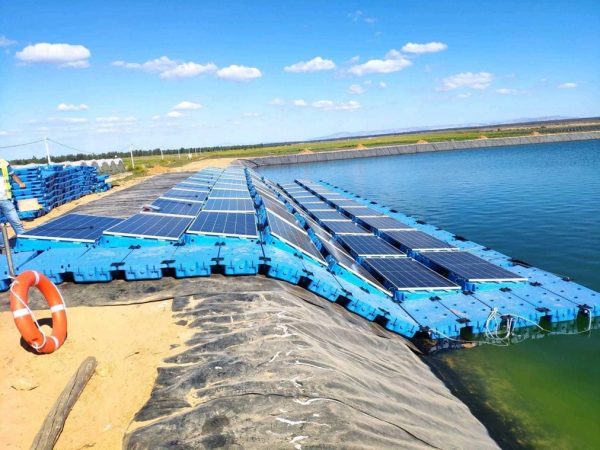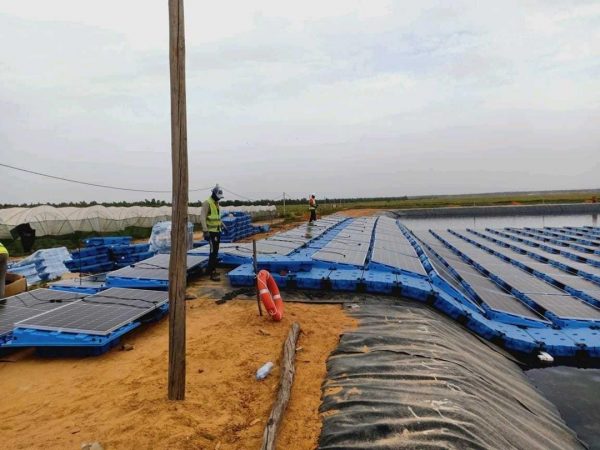Solarity introduces first floating system in Morocco
In the last decade the total numbers of installed PV systems has skyrocketed. The total annual PV power increased by 25-30% since 2015 and in 2021 it will reach the figure of 950 GWp. This was made possible by the price reduction of PV modules (from 0.6 $/W in 2015 to 0.38 $/W in 2019), together with new restrictions and local support programs.
The typical mounting type of PV installations with the capacity of more than 250 MW is ground mount. These installations are called PV stations. The total global capacity of utility-scale PV plants is 633 GW which generated around 3% of global power during 2019. The predicted capacity of all installed PV stations will be around 19.000 GW in 2050 which will cover half of the global demand. The cost of the installation depends mainly upon type of soil and distance to the connection point

Ground and roof mounting installations are not the only type of PV system. Thirteen years ago, the first floating PV installation was built. In 2013 the total capacity of all floating PV systems surpassed 1.2 MW. In 2018 the total capacity of the floating PV stations reached 750 MW which is almost twice compared to previous years (453MW in 2017). As you can see, floating PV installations are getting increasingly more popular despite higher costs when compared to ground mounting systems. The total cost of a floating installation is 10-15% more expensive. This is because the system design is more complicated. The structure must withstand not just constant mechanical, wind or snow load, but also movement of waves and changes of the water level. The PV cables should be protected not just from UV rays, but from rising or lowering water levels as well. Moreover, the safety restrictions are way higher than ground mounting systems.
The floating PV system has a wide range of benefits. First, water performs as a natural cooler. This is critical for systems installed in hot climates (for example in desertic areas). High outdoor temperature combined with the heat radiation from the modules can reduce the efficiency of the system. For example, at a temperature of 65 ˚C the installation is 16% less efficient. Moreover, the natural cover of a lake or reservoir by floating installation greatly reduces the evaporation of water.

The above-mentioned criteria were considered during the installation of a floating PV system in Sidi Slimane, Morocco. This installation was the first type of its kind not just in Morocco, but in North Africa. The system should protect the rainwater used for the cultivation of plants from evaporation. That’s why the entire surface of the reservoir is covered with panels. Furthermore, the installed system had to ensure 30% of bill savings. Solarity delivered 800 modules of CanadianSolar 450W which gave a total capacity of 360kW. Energy Handle installed and commissioned a new floating system. According to calculations, the installation will prevent 12.000 tons of CO2 emissions during 25 years of installation lifetime.

The panels were installed on top of special floating constructions:
- PV panels modular float – injection plastic manufactured, using the best materials (virgin blue HDPE, UV and anti-corrosion additives), 5˚ tilted.
- Secondary float – walkways.
20 rows of 10 modular floats were all connected, which made up a field of 200 panels. In total, there were assembled 4 fields (800 panels) that covered the entire surface of the reservoir. The fields were separated by floating walkways ensuring the maintenance of the system. Floats connectors with screws and nuts were used to connect all the floats together. The entire floating PV was anchored to the shores of the reservoir with special ropes to ensure the stability of the system.

There are already plans to expand the existing system. We are looking forward to similar cooperation projects. At Solarity, installations like this make us thrive and we are more than happy to help you with your most challenging projects. Don’t hesitate to contact us!
Posts you might like:

Subscribe to our newsletter
so that you don’t miss any news!









